

Part 1 of Profitero’s “3P Effect” series
The growing volume on Amazon being captured by third-party (3P) sellers is an issue that brands can’t ignore. In 2008, 30% of Amazon’s online sales were via 3P sellers. Fast forward a decade and that figure has practically doubled, to 58% in 2018.
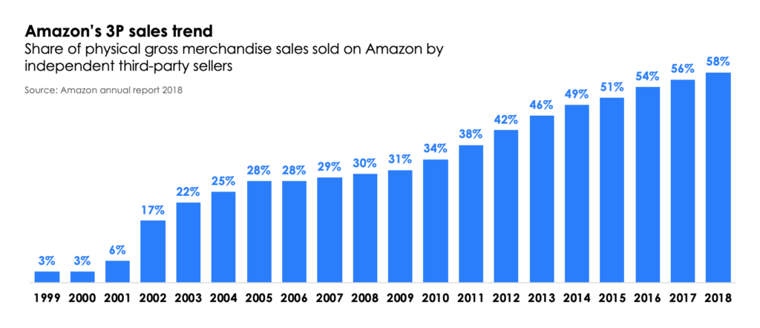
“When speaking to brand manufacturers about ‘losing sales to 3rd parties,’ I often get the push back that it doesn’t matter who sells the products, as long as they are selling. However, quite often brands don’t realize the full consequences of losing control of the sales. With the increase in share that 3P sellers are getting on Amazon, it’s essential that brands have a strategy in place to better measure and manage the 1P/3P dynamic.”
David Halls | Sales Director, Profitero
What does this increasing 3P presence on Amazon mean? Why should brands care?
Because not only are 3P sellers eating your lunch by undercutting your prices and stealing your sales, but when 3P merchants hawk outdated (liquidated) or fake versions of your products, it can absolutely destroy your brand equity and risk your reputation. However, not everything about 3P sellers is bad — brands can often pick up innovation cues from the 3P marketplace.
Here we have compiled the good, the bad and the downright ugly of 3P seller activity:
3P seller activity: The good
Your next big idea could be inspired by a 3P seller.
Low barriers to entry enable the Amazon Marketplace to serve as a launching pad for new and innovative products that are frequently only available online and not in brick-and-mortar stores (i.e., digital natives). In fact, these 3P-originated products are a force to be reckoned with, representing 38% of product sales on Amazon in the U.S. (42% in the U.K.).
So, if you’re not already doing so, you should get in the habit of regularly tracking new ASINs cropping up on Amazon 3P to help identify product trends and NPD opportunities.
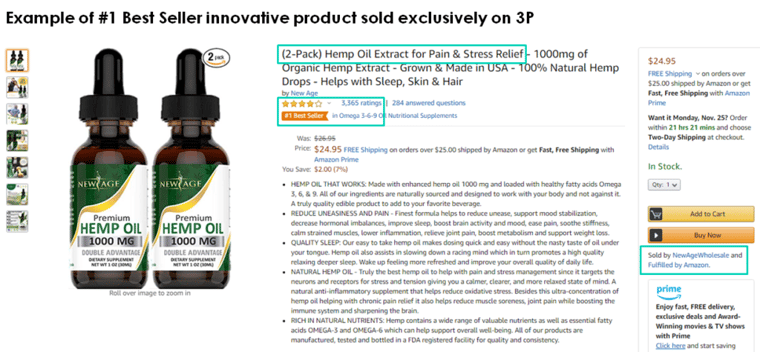
3P sellers often signal unmet consumer needs in your brand portfolio.
It’s also not uncommon for 3P merchants to offer a plethora of different price-pack sizes or unique bundles of popular products not directly available through Amazon 1P. It’s good to keep a watchful eye on these 3P “variant” offerings as a way to identify distribution gaps for items with high demand and economic viability.
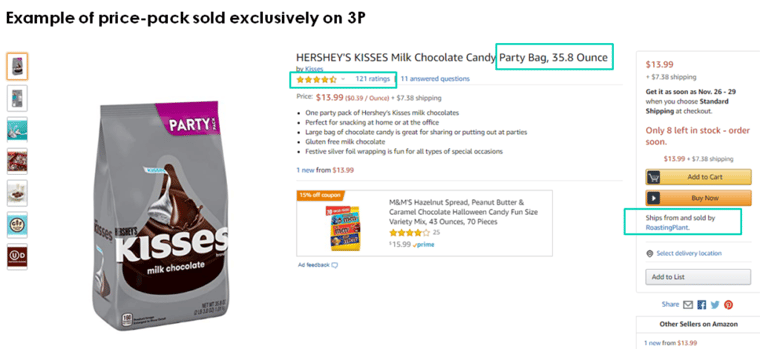
3P seller activity: The bad
You don’t get sales credit when 3P wins the Buy Box.
If you go out-of-stock on Amazon 1P or a 3P player undercuts you on price, then a 3P seller usually ends up winning the Buy Box. The result can be millions in lost sales a year. We analyzed 15,000+ products across multiple categories on Amazon.com in the U.S., and found that in a single month’s time, manufacturers lost, on average, 6% of their sales to 3P sellers. In the U.K., the figure was double that (13% when studying 6,000 products). Of course, the 3P challenge varies by category and brand. (We’re conducting additional research on the 3P effect, which we’ll be sharing out in future blogs. So stay tuned.)
In order to reclaim sales being lost to 3P, you need to know why you’re losing the Buy Box. We suggest you start by identifying the ASINs with the largest sales volume leaking to 3P sellers and understand the reasons why. It typically comes down to an item’s price or if it’s in-stock on Amazon 1P.
Price is by far the single biggest reason for losing the Buy Box.
According to our research, brands lose the Buy Box nine times out of 10 (89%) because they’re being undercut on price by 3P sellers. According to our November 2019 shopper survey, 57% of U.S. shoppers say it doesn’t matter if they buy products directly from Amazon or another third-party merchant as long as they get the lowest price.
Working with our clients, we’ve seen 3P merchants undercut Amazon prices by as much as 40% to win the Buy Box. This level of discounting can be detrimental to a brand’s business economics.
Let’s look at an example. Amazon 1P reduced its price on this particular toy product in January 2018. The 3P seller subsequently lowered its higher price to match Amazon’s new selling price. After a few days, however, Amazon 1P went out-of-stock as a result of the lower price. The 3P seller then took advantage of the situation by increasing the price back to the original higher price point. Meanwhile, Amazon 1P continued to lose sales.
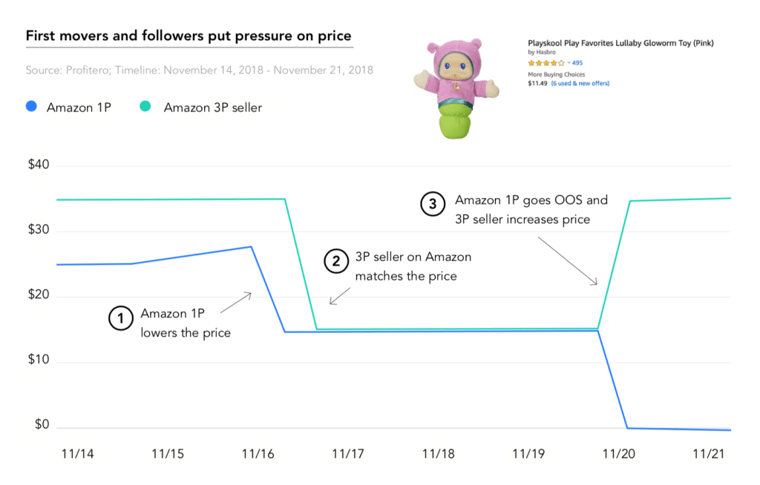
No excuse: Availability is table stakes these days.
Our research shows that, on average, 11% of the time brands lose the Buy Box it’s due to stock issues. Managing out-of-stocks has gotten a bit easier in recent years as Amazon has scaled up its Direct Fulfillment/Dropship program.
The program enables brands to set up direct fulfillment as an inventory backstop in the event their products go out-of-stock in Amazon’s warehouses (Amazon 1P). This way Amazon can continue accepting customer orders, they will just temporarily be fulfilled directly by brands until Amazon’s stock is replenished. This direct-fulfillment option likely is keeping a lid on the percentage of sales lost to 3P due to out-of-stocks.
Still, losing the Buy Box even 11% of the time due to OOS can quickly add up. And it plays right into the hands of 3P — because if you run into stock issues, there’s almost always a 3P seller on the Marketplace waiting to pick up the slack. This example demonstrates how big the lost sales opportunity can be if you run into inventory issues. A popular electronics brand lost nearly half a million pounds in a three-month period by being OOS on Amazon.co.uk.
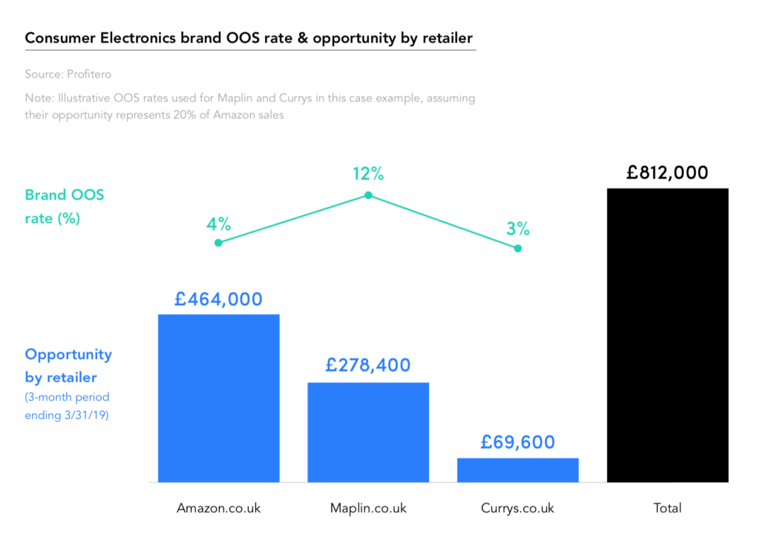
Note: 3P sellers have an especially strong impact in the electronics space, capturing more than half of Amazon’s sales in some categories.
To learn more, download The Amazon Playbook for Consumer Electronics brands.
You lose some control of your content and brand messaging to 3P.
Sales aren’t the only thing lost to 3P. It’s an uneasy feeling, but you will also lose some control of your brand, e.g., content and messaging, to 3P. For instance, 3P sellers on Amazon Marketplace could be using non-compliant product descriptions or images.
This becomes obvious when comparing the differences between a 1P and 3P listing for the First Alert product shown below. The 3P seller “Amazing Deals” listing contains just a single image (versus seven high-resolution images on the Amazon 1P product detail page), no bullet content, and lacks any enhanced product content from the manufacturer below-the-fold.
These kinds of inconsistencies could inevitably hurt the brand image you want to convey.
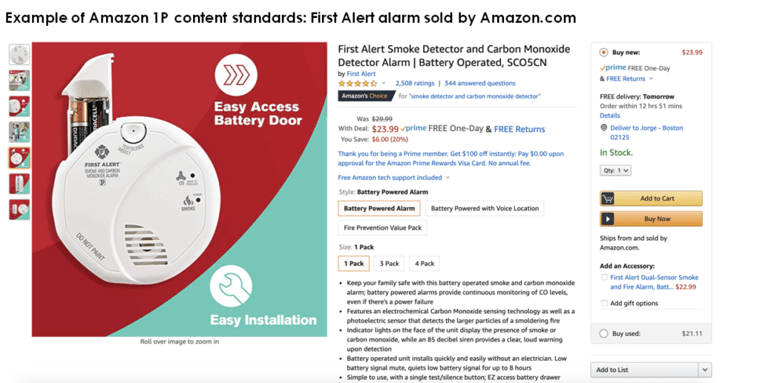

3P seller activity: The ugly
When 3P sellers start messing with the brand itself, and its reputation, things can get really ugly. Many “bad” products — including counterfeits, expired or out-of-date merchandise — can circulate online. The repercussions for your brand can be far-reaching, especially if the products being sold pose a serious security or health risk.
Fake or counterfeit products usually can be traced back to unauthorized 3P sellers.
For example, Inc. magazine reported a story of a fake popular child’s pacifier, the Mustachifier, which was being manufactured in China and sold to U.S. consumers via Amazon’s third-party marketplace. The genuine manufacturer was only alerted to the counterfeit product by consumer reviews where the product was noted to be defective. They alerted the issue to Amazon to remove the products but would have been blind if not for careful monitoring of consumer feedback. More recently, the news of Nike severing ties with Amazon has brought the issue of unauthorized sellers and counterfeit products on Amazon to the forefront.
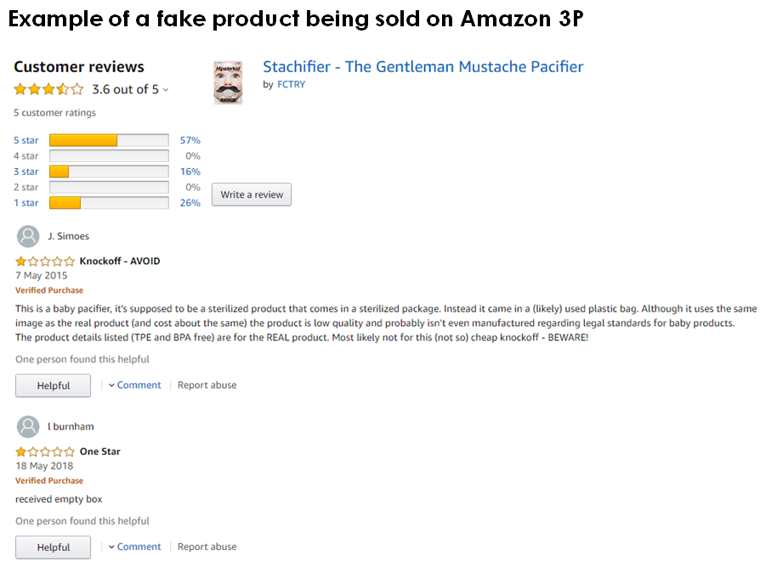
Brand reputation can take a huge hit from expired or outdated products sold on 3P.
A recent article from CNBC points to several examples of expired food products purchased through 3P sellers on Amazon, which left consumers scared and angry, and put the reputation of brands at risk given the onslaught of negative reviews. So, if not already obvious, tight control over your supply chain is essential. You should have a good grasp on all your authorized distributors, and be able to trace the chain of custody of any given item.
Key takeaways: What can brands do?
Track 3P activity with an analytics solution.
All brands need to have an analytics solution in place to monitor the dynamics of 3P seller activity on Amazon. An eCommerce performance analytics platform like Profitero’s will allow you to:
- Size your sales loss due to 3P sellers and identify 3P sellers winning the Buy Box.
- Understand when and, perhaps more importantly, why you’re losing the Buy Box so you can take appropriate actions.
- Detect non-compliant content on 3P seller product detail pages, which could detract from your brand image and messaging.
- Get alerted immediately when 3P sellers are undercutting your prices on Amazon 1P; identify first-movers and followers in the price wars; and isolate any Minimum Advertised Price (MAP) violations.
- Stay on top of new negative reviews so your customer service teams can nip any issues before they balloon into something that can cause real damage to your brand reputation.
Tighten up your supply chain.
It’s crucial that every brand maintain total and tight control over their supply chain and distribution network.
- Think about partnering with fewer, trusted distributors, which could make it easier for brands to track chain of custody and pinpoint unauthorized resellers on Amazon’s Marketplace.
- Implement, and enforce, a MAP policy in North America, which gives you the ability to target and remove those unauthorized sellers.
- Carefully consider enrolling in the programs Amazon is rolling out, which are intended to protect brand reputation and intellectual property, and better control and alleviate counterfeit problems: Amazon Brand Registry; item-level authentication service Transparency; and self-service counterfeit removal program Project Zero.
Request a demo to find out more about Profitero’s digital shelf analytics, including how we help suppliers manage the challenges of 3P on Amazon.


























